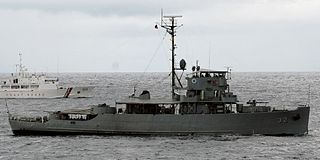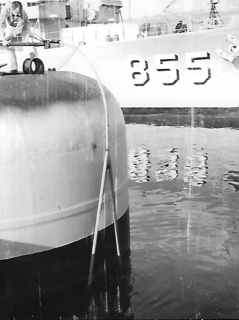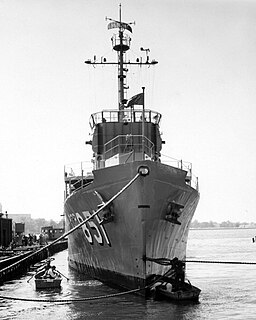The United States Navy, United States Coast Guard, and United States National Oceanic and Atmospheric Administration (NOAA) use a hull classification symbol to identify their ships by type and by individual ship within a type. The system is analogous to the pennant number system that the Royal Navy and other European and Commonwealth navies use.

Somersworth is a city in Strafford County, New Hampshire, United States. The population was 11,855 at the 2020 census. Somersworth has the smallest area and third-lowest population of New Hampshire's 13 cities.
USS Execute (AM-232) was an Admirable-class minesweeper built for the United States Navy during World War II. She was originally ordered and laid down as USS PCE-905, the lead ship of the PCE-905 class of patrol craft. She was reclassified as an Admirable-class minesweeper by the time of her June 1944 launch, and named Execute by the time of her November 1944 commissioning. After service in the Pacific during World War II, she was decommissioned in August 1946 and placed in reserve. While she remained in reserve, Execute was reclassified as MSF-232 in February 1955 but never reactivated. In 1962, she was sold to the Mexican Navy and renamed ARM DM-03. In 1994, she was renamed ARM General Juan N. Méndez (C51). She was stricken in July 2001, but her ultimate fate is not reported in secondary sources.
USS SC-255, sometimes styled as either Submarine Chaser No. 255 or S.C.-255, was an SC-1-class submarine chaser built for the United States Navy during World War I. Like most members of her class, she was not named and known only by her designation.
USS SC-277, sometimes styled as either Submarine Chaser No. 277 or S.C.-277, was an SC-1-class submarine chaser built for the United States Navy during World War I. Like most members of her class, she was not named and known only by her designation.

USS SC-48, sometimes styled as either Submarine Chaser No. 48 or S.C.-48, was an SC-1-class submarine chaser built for the United States Navy during World War I. Like most members of her class, she was not named and known only by her designation.

BRP Miguel Malvar (PS-19) is the lead ship of the Miguel Malvar class of corvettes of the Philippine Navy. She was originally built as USS Brattleboro PCE(R)-852, a PCE(R)-848-class rescue patrol craft escort for the United States Navy during World War II. In 1966 she was transferred to South Vietnam for service in the Republic of Vietnam Navy as RVNS Ngọc Hồi (HQ-12). She was acquired by the Philippine Navy in April 1976 and later on commissioned as Miguel Malvar after Miguel Malvar y Carpio. The ship is in active service. Along with other World War II-era ships of the Philippine Navy, Miguel Malvar is one of the oldest active fighting ships in the world today.

BRP Sultan Kudarat (PS-22) was a Miguel Malvar-class corvette of the Philippine Navy. She was originally built as USS PCE-881, a PCE-842-class patrol craft for the United States Navy during World War II. In 1961 she was transferred to South Vietnam for service in the Republic of Vietnam Navy as RVNS Đống Đa II (HQ-07). She was acquired by the Philippine Navy on April 1976, and was commissioned later on as RPS Sultan Kudarat (PS-22). Along with other World War II-era ships of the Philippine Navy, Sultan Kudarat was considered one of the oldest active fighting ships in the world, until her retirement in 05 July 2019.
BRP Datu Marikudo (PS-23) was a Malvar-class corvette of the Philippine Navy. She was originally built as USS PCE(R)-853, a PCE(R)-848-class patrol craft for the United States Navy during World War II. She was renamed USS Amherst on 15 February 1956. In February 1970, Amherst was decommissioned and transferred to South Vietnam for service in the Republic of Vietnam Navy as RVNS Vạn Kiếp II (HQ-14). She remained in South Vietnamese service until the collapse of that country in 1975. Vạn Kiếp II was one of several ships that fled from South Vietnam to the Philippines. She was then commissioned into the Philippine Navy on 5 April 1976 and named in honor of Datu Marikudo. Along with other World War II-era ships of the Philippine Navy, Datu Marikudo was considered one of the oldest active fighting ships in the world until her decommissioning.

BRP Cebu (PS-28) was a Miguel Malvar-class corvette of the Philippine Navy. She was originally built as USS PCE-881, a PCE-842-class patrol craft for the United States Navy during World War II and patrolled the Alaskan coast during that war. She was decommissioned from the U.S. Navy and transferred to the Philippine Navy in July 1948 and renamed RPS Cebu (E-28) after the Philippine province of the same name. The ship was decommissioned on 1 October 2019. Along with other World War II-era ships of the Philippine Navy, Cebu was considered one of the world's oldest fighting ships during her active service.
RPS Leyte (PS-30) was a Miguel Malvar-class corvette of the Philippine Navy. She was originally built as USS PCE-885, a PCE-842-class patrol craft for the United States Navy during World War II. She was decommissioned from the U.S. Navy and transferred to the Philippine Navy in July 1948 and renamed Leyte. The ship was decommissioned from the Philippine Navy in 1978 after she ran aground and was damaged beyond repair.

BRP Pangasinan (PS-31) was a Miguel Malvar-class corvette of the Philippine Navy. She was originally built as USS PCE-891, a PCE-842-class patrol craft for the United States Navy during World War II. She was decommissioned from the U.S. Navy and transferred to the Philippine Navy in July 1948 and renamed RPS Pangasinan (E-31).

BRP Iloilo (PS-32) was a Miguel Malvar-class corvette of the Philippine Navy. She was originally built as USS PCE-897, a PCE-842-class patrol craft for the United States Navy during World War II. She was decommissioned from the U.S. Navy and transferred to the Philippine Navy in July 1948 and renamed RPS Iloilo (E-32) after the Philippine province of the same name. Along with other World War II-era ships of the Philippine Navy, Iloilo was considered one of the oldest active fighting ships in the world, being in continuous service for over seven decades.

The PCE-842-class patrol craft were United States Navy patrol craft escorts designed during World War II that were intended for coastal and convoy escort. The design was derived from the 180-foot (55 m) Admirable-class minesweeper as a substitute for the 173-foot (53 m) PC-461-class submarine chasers that were used for anti-submarine warfare (ASW) in coastal areas. At 185 feet long and 640 tons, the PCE is more than twice the displacement of the PC. It has a crew complement of 99 officers and men.
ROKS Dangpo was a patrol craft of the Republic of Korea Navy (ROKN). Originally built as USS PCE-842, a PCE-842-class patrol craft for the United States Navy during World War II. Dangpo was acquired by South Korea on 13 December 1961 and sunk by North Korean coastal artillery fire on 19 January 1967.

USS Rexburg was built as a PCE(R)-848-class rescue escort patrol craft for the United States Navy during World War II. She was unnamed until 1956. After working through the 1950s and 60s as an oceanographic research vessel for the Navy Electronics Laboratory, Rexburg was decommissioned in 1970 and sold to the Church of Scientology as MV Excaliber.

The USS Havre was a United States Navy PCE-842-class patrol craft escort in commission from 14 February 1944 to 1 July 1970. She served in the Central Pacific during World War II, supporting invasions of Battle of Iwo Jima and the Battle of Okinawa, and was present in Tokyo Bay for the formal Surrender of Japan on 2 September 1945. Unlike other ships from this class, which were scrapped or sold to other nations, the (PCE-877) stayed the property of the United States Navy, who transferred ownership to the United States Navy Reserve as Naval Reserve Training Ship for 9th Naval District (Chicago) in April 1954. She was renamed USS Havre (PCE-877) on 15 February 1956 as part of a Navy-wide initiative to provide names to all numbered ships. The USS Havre served on Great Lakes until struck from Navy list 1 July 1970.

USS Rockville (EPCER-851), previously USS PCE(R)-851, PCER-851 and later ARC San Andres, was a PCE-842-class patrol craft of the United States and Colombian navies. Named after small towns in Maryland and Connecticut, she was the only U.S. naval vessel to bear the name.

USS Somersworth was a United States Navy PCE(R)-848-class Patrol Craft Escort (Rescue), in commission from April 1944 to September 1965. The ship was named after the city of Somersworth, New Hampshire.












